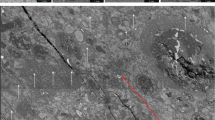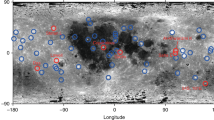Abstract
Finding the basic mechanism governing the surface history of asteroids of various shapes is essential for understanding their origin and evolution. In particular, the asteroids (162173) Ryugu1 and (101955) Bennu2 currently being visited by Hayabusa2 and OSIRIS-REx appear to be top shaped. This distinctive shape, characterized by a raised equatorial bulge, is shared by other similarly sized asteroids, including Didymos A3, 2008 EV54 and 1999 KW4 Alpha5. However, the possibly common formation mechanism that causes the top-like shape is still under debate. One clue may lie in the boulders on their surfaces. The distribution of these boulders, which was precisely measured in unprecedented detail by the two spacecraft1,2, constitutes a record of the geological evolution of the surface regolith since the origin of these asteroids. Here, we show that during the regolith migration driven by Yarkovsky–O’Keefe–Radzievskii–Paddack spin-up6,7,8,9 the surface boulders coevolve with the underlying regolith and exhibit diverse dynamical behaviours: they can remain undisturbed, sink into the regolith layer and become tilted, or be totally buried by the downslope deposition, depending on their latitudes. The predominant geological features commonly observed on top-shaped asteroids, including the boulder-rich region near the pole1,10, the deficiency of large boulders in the equatorial area10,11 and partially buried, oblique boulders exposed on the regolith surface12,13, are commensurate with this coevolution scenario. The surface regolith migration thus is the prevalent mechanism for the formation history of the top-shaped asteroids with stiffer cores.
This is a preview of subscription content, access via your institution
Access options
Access Nature and 54 other Nature Portfolio journals
Get Nature+, our best-value online-access subscription
$29.99 / 30 days
cancel any time
Subscribe to this journal
Receive 12 digital issues and online access to articles
$119.00 per year
only $9.92 per issue
Buy this article
- Purchase on Springer Link
- Instant access to full article PDF
Prices may be subject to local taxes which are calculated during checkout




Similar content being viewed by others
Data availability
The data that support the plots within this paper and other findings of this study are available from the corresponding authors upon reasonable request. Data used in Fig. 4d, e and f can be found at http://darts.isas.jaxa.jp/pub/hayabusa2/onc_bundle/ under image indexes hyb2_onc_20180831_101059_tvf_12a, hyb2_onc_20180801_160642_tnf_l2c and hyb2_onc_20180720_075208_tvf_l2b, respectively.
Code availability
The code used to generate the datasets is available from the corresponding authors on reasonable request.
References
Watanabe, S. et al. Hayabusa2 arrives at the carbonaceous asteroid 162173 Ryugu—a spinning top-shaped rubble pile. Science 364, 268–272 (2019).
Lauretta, D. S. et al. The unexpected surface of asteroid (101955) Bennu. Nature 568, 55–60 (2019).
Benner, L. A. et al. Radar imaging and a physical model of binary asteroid 65803 Didymos. Bull. Am. Astron. Soc. 42, 1056 (2010).
Busch, M. W. et al. Radar observations and the shape of near-Earth asteroid 2008 EV5. Icarus 212, 649–660 (2011).
Ostro, S. J. et al. Radar imaging of binary near-Earth asteroid (66391) 1999 KW4. Science 314, 1276–1280 (2006).
Walsh, K. J., Richardson, D. C. & Michel, P. Rotational breakup as the origin of small binary asteroids. Nature 454, 188–191 (2008).
Hirabayashi, M., Sánchez, P. & Scheeres, D. J. Internal structure of asteroids having surface shedding due to rotational instability. Astrophys. J. 808, 63 (2015).
Sánchez, P. & Scheeres, D. J. Rotational evolution of self-gravitating aggregates with cores of variable strength. Planet. Space Sci. 157, 39–47 (2018).
Sánchez, P. & Scheeres, D. J. Cohesive regolith on fast rotating asteroids. Icarus 338, 113443 (2020).
Michikami, T. et al. Boulder size and shape distributions on asteroid Ryugu. Icarus 331, 179–191 (2019).
DellaGiustina, D. N. et al. Properties of rubble-pile asteroid (101955) Bennu from OSIRIS-REx imaging and thermal analysis. Nat. Astron. 3, 341–351 (2019).
Sugita, S. et al. The geomorphology, color, and thermal properties of Ryugu: implications for parent-body processes. Science 364, 252 (2019).
Walsh, K. J. et al. Craters, boulders and regolith of (101955) Bennu indicative of an old and dynamic surface. Nat. Geosci. 12, 242–246 (2019).
Cundall, P. A. & Strack, O. D. A discrete numerical model for granular assemblies. Géotechnique 29, 47–65 (1979).
Sánchez, P. & Scheeres, D. J. Simulating asteroid rubble piles with a self-gravitating soft-sphere distinct element method model. Astrophys. J. 727, 120 (2011).
Schwartz, S. R., Richardson, D. C. & Michel, P. An implementation of the soft-sphere discrete element method in a high-performance parallel gravity tree-code. Granul. Matter 14, 363–380 (2012).
Barnouin, O. S. et al. Shape of (101955) Bennu indicative of a rubble pile with internal stiffness. Nat. Geosci. 12, 247–252 (2019).
Arakawa, M. et al. An artificial impact on the asteroid (162173) Ryugu formed a crater in the gravity-dominated regime. Science 368, 67–71 (2020).
Wright, E. et al. Boulder stranding in ejecta launched by an impact generated seismic pulse. Icarus 337, 113424 (2020).
Matsumura, S. et al. The Brazil nut effect and its application to asteroids. Mon. Not. R. Astron. Soc. 443, 3368–3380 (2014).
Scheeres, D. J. et al. The dynamic geophysical environment of (101955) Bennu based on OSIRIS-REx measurements. Nat. Astron. 3, 352–361 (2019).
Reddy, K., Forterre, Y. & Pouliquen, O. Evidence of mechanically activated processes in slow granular flows. Phys. Rev. Lett. 106, 108301 (2011).
Germanovich, L. N., Kim, S. & Puzrin, A. M. Dynamic growth of slip surfaces in catastrophic landslides. Proc. Math. Phys. Eng. Sci. 472, 20150758 (2016).
Nichol, K., Zanin, A., Bastien, R., Wandersman, E. & van Hecke, M. Flow-induced agitations create a granular fluid. Phys. Rev. Lett. 104, 078302 (2010).
Walsh, K. J. et al. Bennu’s global geology. In Proc. 50th Lunar and Planetary Science Conference LPSC2019-1898 (LPI, 2019).
Gray, J. M. N. T. Particle segregation in dense granular flows. Annu. Rev. Fluid Mech. 50, 407–433 (2018).
Michel, P. et al. Collisional formation of top-shaped asteroids and implications for the origins of Ryugu and Bennu. Nat. Commun. 11, 2655 (2020).
Tardivel, S., Sánchez, P. & Scheeres, D. J. Equatorial cavities on asteroids, an evidence of fission events. Icarus 304, 192–208 (2018).
Hirabayashi, M. et al. The western bulge of 162173 Ryugu formed as a result of a rotationally driven deformation process. Astrophys. J. Lett. 874, L10 (2019).
Cheng, B., Yu, Y. & Baoyin, H. Numerical simulations of the controlled motion of a hopping asteroid lander on the regolith surface. Mon. Not. R. Astron. Soc. 485, 3088–3096 (2019).
Somfai, E., Roux, J.-N., Snoeijer, J. H., Van Hecke, M. & Van Saarloos, W. Elastic wave propagation in confined granular systems. Phys. Rev. E 72, 021301 (2005).
Zhang, Y. et al. Rotational failure of rubble-pile bodies: influences of shear and cohesive strengths. Astrophys. J. 857, 15 (2018).
Peters, J. F., Muthuswamy, M., Wibowo, J. & Tordesillas, A. Characterization of force chains in granular material. Phys. Rev. E 72, 041307 (2005).
Hayabusa2 Optical Navigation Camera (ONC) Dataset (JAXA Data Archives and Transmission System (DARTS), 2019); http://darts.isas.jaxa.jp/pub/hayabusa2/onc_bundle
Acknowledgements
This work is funded by the National Science Fund for Distinguished Young Scholars of China (no. 11525208). Y.Y. acknowledges support from the Natural Science Foundation of China (no. 11702009). P.M. acknowledges funding from the French space agency CNES, from the European Union’s Horizon 2020 research and innovation programme under grant agreement no. 870377 (project NEO-MAPP) and from Academies of Excellence: Complex systems and space, environment, risk, and resilience, part of the IDEX JEDI of the Université Côte d’Azur. We acknowledge support from the JSPS Core-to-Core programme ‘International Network of Planetary Sciences’. We are grateful to the Hayabusa2 ONC team for providing images, which are available at the JAXA Data Archives and Transmission System (DARTS) at http://darts.isas.jaxa.jp/pub/hayabusa2/onc_bundle.
Author information
Authors and Affiliations
Contributions
B.C. performed the soft-sphere numerical simulations and analysed the numerical results. H.B. and Y.Y. initiated the project, designed the simulations and led the research. E.A. and D.C.R. contributed to the discussion of the two-layer model and the creeping process. M.H. provided essential comments on the interior structure and deformation. P.M. initiated the collaboration between the institutions with Y.Y. and provided outstanding questions on the scope of the research with M.Y. All authors contributed to interpretation of the results and preparation of the manuscript.
Corresponding authors
Ethics declarations
Competing interests
The authors declare no competing interests.
Additional information
Peer review information Nature Astronomy thanks David Polishook and the other, anonymous, reviewer(s) for their contribution to the peer review of this work.
Publisher’s note Springer Nature remains neutral with regard to jurisdictional claims in published maps and institutional affiliations.
Supplementary information
Supplementary Information
Supplementary methods, Tables 1 and 2 and Figs. 1–7.
Supplementary Video 1
Moderate friction. 75° LBx boulder. Coloured by slip heat.
Supplementary Video 2
Moderate friction. 75° LBx boulder. Coloured by latitude.
Supplementary Video 3
Moderate friction. 87° LBx boulder. Coloured by latitude.
Supplementary Video 4
Moderate friction. 45° LBx boulder. Coloured by latitude.
Supplementary Video 5
Moderate friction. 15° LBx boulder. Coloured by latitude.
Supplementary Video 6
Gravel-like friction. 75° LBx boulder. Coloured by latitude.
Supplementary Video 7
Moderate friction. Regolith bed with width of 160 m.
Supplementary Video 8
Moderate friction. Regolith bed with wedge-shaped boundaries.
Supplementary Video 9
Moderate friction. Regolith bed of both hemispheres.
Supplementary Video 10
Moderate friction. 45° LBx boulder initially buried in regolith.
Supplementary Video 11
Moderate friction. 15° LBx boulder initially buried in regolith.
Supplementary Video 12
Moderate friction. Multiple boulders.
Rights and permissions
About this article
Cite this article
Cheng, B., Yu, Y., Asphaug, E. et al. Reconstructing the formation history of top-shaped asteroids from the surface boulder distribution. Nat Astron 5, 134–138 (2021). https://doi.org/10.1038/s41550-020-01226-7
Received:
Accepted:
Published:
Issue Date:
DOI: https://doi.org/10.1038/s41550-020-01226-7
This article is cited by
-
Measuring the mechanical properties of small body regolith layers using a granular penetrometer
Astrodynamics (2023)
-
Accelerating binary asteroid system propagation via nested interpolation method
Celestial Mechanics and Dynamical Astronomy (2023)
-
Inferring interiors and structural history of top-shaped asteroids from external properties of asteroid (101955) Bennu
Nature Communications (2022)
-
Long-term trends of regolith movement on the surface of small bodies
Nonlinear Dynamics (2022)
-
Shapes, structures, and evolution of small bodies
Astrodynamics (2021)



